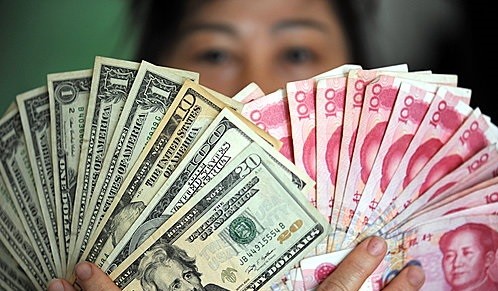
[Special Economy=Eunji Kim]As the Chinese economic slowdown continues, the won is strengthening against the dollar, bringing anxiety to Korea's financial market.
Last Friday, the won recorded at 1214.75 against the dollar; early in the market, the won fell to 1210 against the dollar but with the Chinese economic volatility, it later held steady.
Prior to this, the won has jumped 3.48% to 1172.5 against the dollar last year, which means the value of the Korean currency is falling.
Meanwhile, the yuan recorded 6.5637 against the dollar last Friday—the lowest in 5 years. The won and dollar exchange rate is linked with the yuan's and shows an inverse proportionate relationship. If one goes up, the other goes down.

The falling renminbi against the greenback means that the credibility toward how strong China's exports are performing is low.
Last Wednesday, China's maritime customs service reported that the country's last year export scale, in yuan standard, was favorable than expected, increasing 2.3% from the year before.
However: there rose a question of whether these trade earnings have been exaggerated. With that, China's financial market shook—again—and the Shanghai Composite Index crashed 3.55% last Friday, tumbling to 2900.97 points.
“[It's been reported that] last December's massive Hong Kong exports recorded the largest scale in 10 years, but looking at the current China's situation, this can be an exaggeration,” said Lee Joon-hee, researcher at NH Investment & Securities.
“At this time, in the mainland and Hong Kong, the yuan exchange rate spread has been blown up and in this process, it could be that there were fake invoices during arbitrage trading, causing concerns for the credibility in the Chinese market,” she said.
Currently, the restructuring of marginal firms in this country is taking place, and the credit risk of these companies is rising, bringing another bearish factor into the exchange rate market.
“The present manufacturing industry in China has been worsening to the level during the 2008 financial crisis,” said Kim Kyung-hwan, a researcher at Hana Financial Investment Co. “If the government goes with limiting the lending and approving bankruptcy, the marginal firms can become insolvent.”
He continued: “The expiration for corporate bonds that were issued last year is in March, but if some marginal companies go bankrupt, the fluctuation in the market interest rates can increase, bringing down the entire financial market.”
| 위안화 환율 최저치 기록…원‧달러 환율 잇따라 올라가나? [스페셜경제=김은지 기자]지속되고 있는 중국 리스크 때문에 원‧달러 환율은 강세를 이어가며, 국내 금융시장에 불안함으로 다가오고 있다. 15일 원‧달러 환율은 전날 대비 보합인 1214.75원을 기록했다. 장 초반 1210원으로 6원 이상 하락했는데, 원‧달러 환율은 중국 금융시장 변동성으로 인해 낙폭을 보인 후 보합세로 장을 마쳤다. 원·달러환율은 지난해 말 1172.5원 대비 3.48% 급등한 상태다. 이로 인해 원화 가치는 하락하고 있다는 뜻이다. 아울러 위안화 환율은 15일 최근 5년 최저치를 기록해 6.5637위안으로 고시됐다. 원‧달러 환율도 잇따라 동조되며 반비례 관계를 보인다. 따라서 중국 수출지표에 대한 신뢰도가 삐걱거리면서 중국 리스크가 다시 부각된 것이다. 지난 13일 중국 해관총서 발표에 따르면 중국의 지난해 수출 규모가 위안화 기준 전년대비 예상보다 호조를 보였다. 이는 2.3% 오른 것이다. 문제는 중국 무역수지가 부풀려졌다는 의구심이 제기되면서 금융시장은 다시 흔들렸고 15일 상하이종합지수는 전날대비 3.55% 급락해 3000선이 무너져 2900.97을 기록했다. NH투자증권 이준희 연구원은 “지난해 12월 중국의 대 홍콩수출이 12월 기준 10년 만에 가장 큰 규모를 기록했는데 현재 중국 경기상황을 반영했을 때 부풀려졌다는 의혹이 커지고 있다”며 "지난해 12월 본토와 홍콩 간 위안화 환율 스프레드 확대 과정에서 환투기를 노린 세력들이 위조송장으로 차익거래를 시도했을 가능성이 제기되면서 중국 시장에 대한 신뢰도가 크게 약화된 상황“이라고 설명했다. 중국에서는 구조조정이 실행되는 가운데 한계기업들의 신용위험도가 높아지면서 환율 등 금융시장에 또 다시 발목을 잡을 것으로 예상된다. 하나금융투자 김경환 연구원은 “현재 중국 제조업경기는 지난 2008년 금융위기 당시 수준까지 악화된 것으로 평가받고 있는데 이 상황에서 정부가 대출제한, 파산용인 등 작은 결정만 내려도 예상보다 많은 한계기업들의 도산이 이어질 수 있다”며 “지난해 발행된 회사채 만기가 3월에 집중되는데 일부 한계기업의 파산이 발생할 경우 시중금리 변동성을 확대시키며 전체 금융시장에 악재로 작용할 수 있다”고 우려했다.
|

